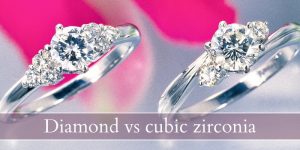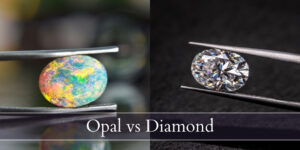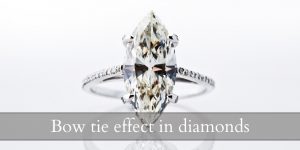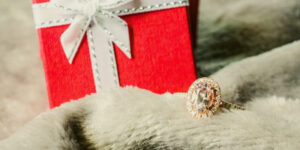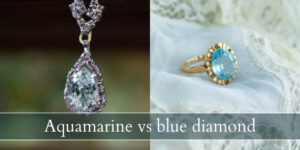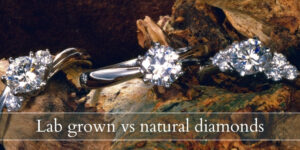Moonstone and pearl have some pretty similar looks, but in the end they’re very different gemstones. Pearls aren’t even gemstones, but are considered precious nonetheless. When it comes to deciding which of these two beauties to mount on your jewelry, there are a few differences you should be aware of. Let’s take a look.
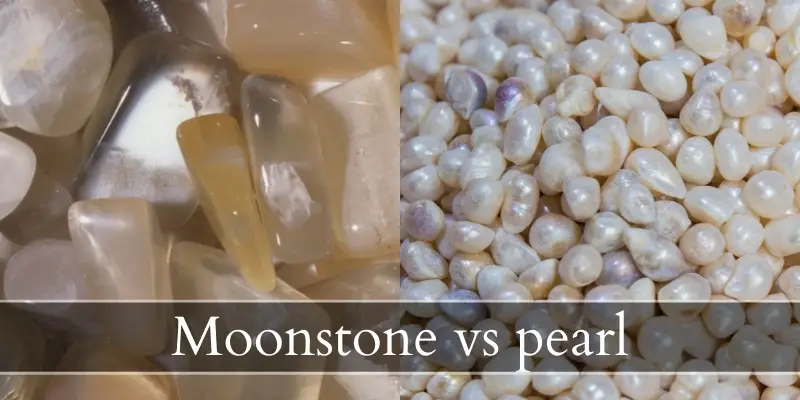
Moonstone vs pearl
Moonstone is a harder material than pearl, so it will wear better and last longer. Pearls are more elegant and provide a very different look than moonstone. Both pearl and moonstone seem to emit light from within because of the way they’re constructed, but a pearl has a definite iridescence while the moonstone has a bluish adularescence that shifts with the light.
The overall cost of owning pearl jewelry is higher than moonstone jewelry, especially if it’s a natural pearl, not farmed. A pearl forms in a very, very different manner than moonstone, and this is reflected in its selling price.
Pearls form differently than moonstones
Pearls start out as very ordinary, actually intrusive objects ! Yes, a pearl forms within a clam or mussel, everyone knows that, but not every shell in a water body will form a pearl. Most don’t.
In truth, the beautiful pearl is the result is a foreign body entering the clam and irritating it. The clam will then form layers of nacre around the offending object, and the process never stops as long as there is something inside the clam. The more nacre layers there are, the bigger the pearl, and the deeper and more beautiful the iridescent sheen.
Moonstones on the other hand are a variety of feldspar, a fairly common mineral found within the earth’s crust. It takes a very long time for moonstone to form, much longer than a pearl, but it is a less precious gem.
Read also: Ruby VS Diamond
Moonstone has a glow, pearl is iridescent
Due to moonstone being made up of mostly feldspar, it’s layered in such a way that when light hits at the right angles, a blue glow or sheen floats just below the stone surface. This glow is known as adularescence, and it can range from white to electric blue, depending on the clarity of the moonstone and how sharply defined the feldspar layers are.
Pearls can also be describe as glowing from within, like moonstone, but it’s a different type of glow. A pearl’s many nacre layers all reflect light through each other, leading to a very radiant and soft looking surface, and varying degrees of iridescence.
A pearl’s nacre is actually derived from the mother of pearl found on the inside of the clam, which shines white, cream, pink, green, and light blue all at the same time, much like an oil spill on water.
Pearls come in several colors, moonstones are mainly white
Pearls actually come in several colors, as each mussel species produces different colors. So you can find pearls in white, beige, light pink, cream, almost golden, greenish, reddish, grey, purplish, bluish, and black. Really there are no two pearls that are the exact same color, unless they come form the exact same oyster. Those are usually farmed or cultured pearls.
Aside from all these colors, pearls come with varying degrees of iridescence. The darker pearls generally display iridescence better, due to the contrast.
Moonstones are almost always white in body, with varying degrees of clarity. Some may appear nearly opaque, some may be completely transparent, and some may be milky, and anything in between. The very clear ones with a nice blue glow may be faceted and sold for a higher price.
Beware of faux moonstone, sold as opalite. This is a man-made lead glass that has a milk-in-water appearance with a bluish tiny, but instead of a blue glow it has a rainbow glow.
Natural pearls are more expensive than moonstone
Because pearls naturally form within an oyster, there is no way to know if an oyster has a pearl or not without opening it. This involved sacrificing the oyster, and this leads to many, many, many of them being opened for nothing, until a pearl is found. This leads to a very high cost when buying a natural pearl.
Natural (wild) pearls can range anywhere between $300 and $1500 for a single pearl. The most expensive and sought-after pearl is the South Sea pearl, and it comes in shade of white and gold. The rounder and bigger the pearl, the higher the price.
Freshwater pearls are much cheaper by comparison, and can be found as low as $50 for a simple white pearl necklace.
Moonstone is much more affordable than natural pearl. A 1.4 carat moonstone cabochon, fairly clear with a blue sheen, goes for about $62. Lower grade moonstone with more opacity and less glow may be even cheaper.
Moonstone is harder than pearl, will wear better
Because moonstone is a type of feldspar, it ranks a 6 on the Mohs scale of hardness. This means it should be set in a protective setting, such as a bezel setting, and almost certainly cut as a cabochon for more structural stability.
Pearls are much, much softer by comparison. They rank anywhere between 2.5 – 4.5 on the hardness scale, And this makes them very prone to scratches, cuts, and even chipping if you’re not careful. Nacre is not the sturdiest material.
For this reason neither moonstone nor pearl should be used as ring gemstones. But if you do, make sure to set them very well into the jewelry. Pearls are pretty fragile, so they’re best used as necklaces or earrings. Keep anything acidic away from pearls as they will eventually dissolve.
Pearls have always been associated with a classy, elegant look
Because pearls have been so expensive throughout history, they’ve always been associated with royalty, class, high status, wealth. A string of real, wild pearls was incredibly hard to come by because no two pearls are the same, and to make a necklace out of them meant you had quite a few pearls to choose from.
In time pearls became more affordable, especially since freshwater pearls became a common jewelry item. You could find a string or pearls for $300 or even less. Still, the association with high class and elegance was so strong that not many people went and bought pearls.
Moonstone on the other hand is much less known. They’re not as common as pearls and they’re rather bought and used by those who would like a different looking stone, or those with a penchant for crystals and mysticism.

I’m the main author for jewelrymaterialguide.com. I started this site after we did tons of research before our wedding and noticed that there is information about rings, jewelry, and so on that is really hard to find on the internet.

